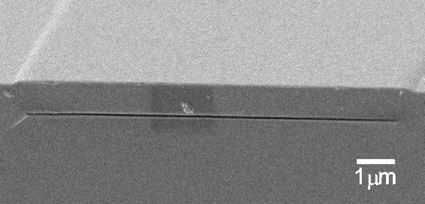Introduction
In the past years the BIOS-chair has gained a lot of knowledge in downscaling systems for biomedical and environmental applications. The miniaturized systems are named Lab-on-Chip (LOC) systems. The reason for applying nanochannels in chemical synthesis and analysis systems is that nanochannels allow chemistry with unique, ultra low fluid quantities in the order of femto (10-15) litres. State-of-the-art larger micro reaction systems demonstrated the advantages of miniaturization, such as low chemicals consumption, improved reaction controllability and quality, fast thermal control and improved safety. Further downsizing towards nanosystems offers the possibility to do extremely selective chemistry and interrupt reactions by ultra fast thermal control. Also the integration of nanochannels with surface coatings (e.g. mono layers) offers new opportunities.
Challenges
Nanochannels are fluidic channels with a height and/or a width smaller than 1 μm (see figure 1 for an example). Scaling down to nanoscale means that you are going to face some challenges: First, because of technological limitations. Second, with these dimensions systems are approaching the boundary where macroscopic laws of physics may no longer be valid. This means that a thorough understanding of processes and phenomena that are dominating on this scale is necessary. Gladly loads of experimental and theoretical work have been done on nanoscale systems in disciplines such as colloid chemistry and biology. Other vital information is available in fluid mechanics and because the surface to volume ratio increases with decreasing channel dimensions, rheology is also an important discipline.

Figure 1: 1D 100 nm high nanochannel with a thin silicon nitride roof
This project
Designs applied to microchannels are tested for their applicability to nanochannels. In the case of flow sensing there is the problem of detection limits. In the case of flow control there is a problem of special behavior, because of extremely low Reynolds numbers and a relatively large surface to volume ratio. However, there are not only problems, but also great opportunities. For instance, because of the large surface to volume ratio, surface drag forces will exert a relatively large force on the fluid volume inside the channel. So pumping techniques which drive the fluid by exerting a surface force may be very efficient.
In this phase of the project an inventory of known principles for flow sensing and control is made. The principles are tested on applicability to nanochannels by applying scaling laws and knowledge of both physics and colloid chemistry.
Funding
This PhD assignment forms part of the flagship Nanofluidics of the NanoNed initiative of the Dutch government and is funded by Nanoned.
Interested?
If you are interested and for instance would like to do your graduation work or practical term, please contact via the email address below.
Contact Information
Wouter Sparreboom and / or Jan Eijkel
MESA+ Institute for Nanotechnology
University of Twente
P.O. Box 217
7500 AE Enschede
The Netherlands
Phone: +31 (0)53 489 3981 (Wouter) / +31 (0)53 489 2839 (Jan)
Fax: +31 (0)53 489 3595
Email: W.Sparreboom@ewi.utwente.nl / J.C.T.Eijkel@utwente.nl
